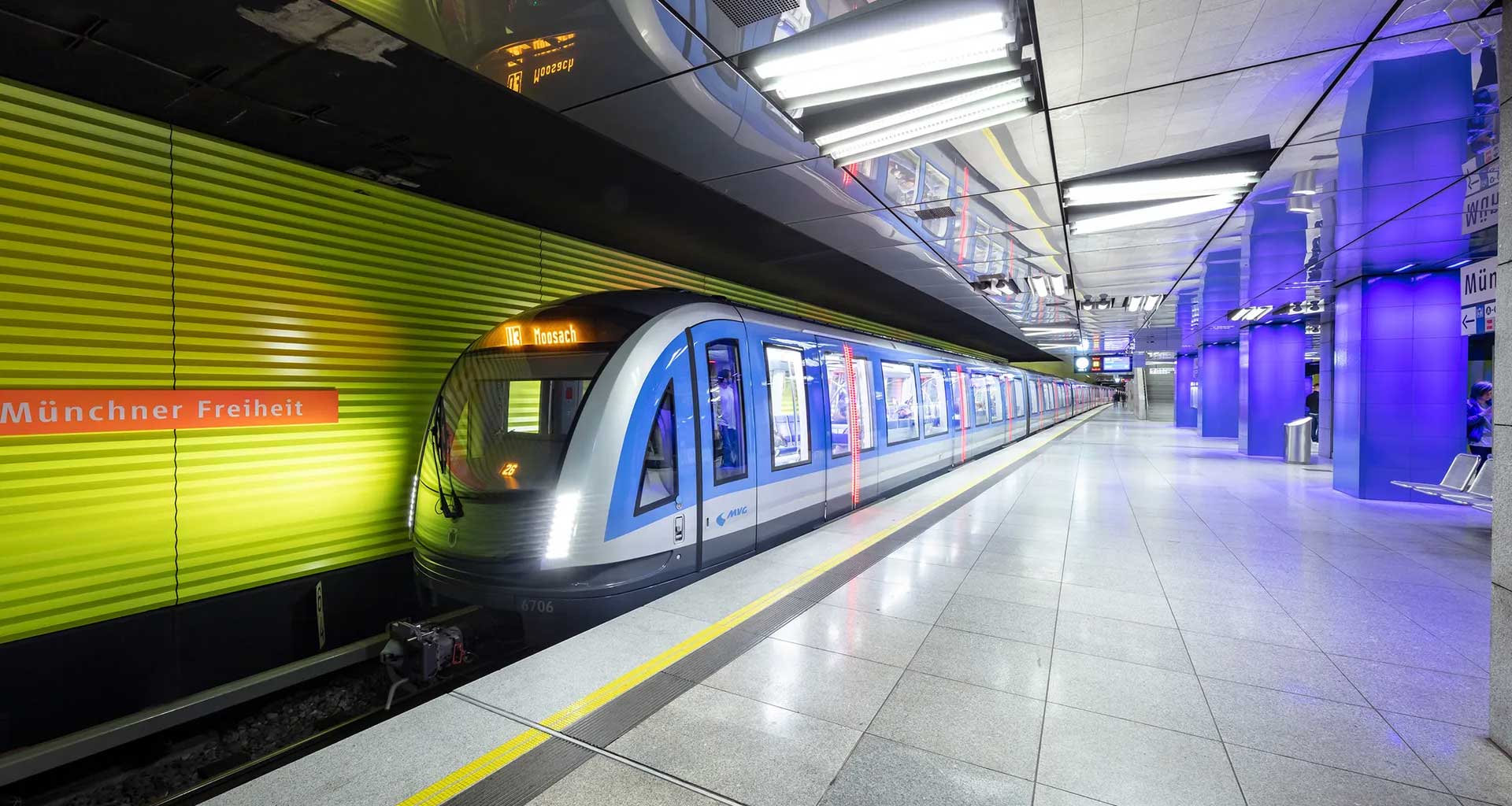
The metropolitan area of Munich is served by an expansive public transportation network that covers nearly all areas of the city and region. The public transportation services are extremely wheelchair accessible, and a model for the rest of Europe. During my recent visit to Munich, the public transit was so efficient and accessible, I didn’t have to turn to private transportation options as is often the case in other international cities. In this guide, I will describe the nature of accessibility on each of the city’s public transit services – trains, trams and buses.
U-Bahn Underground Train/Subway
The U-Bahn is Munich’s metro subway system, and it operates almost entirely underground. There are 8 U-Bahn lines, designated as U1 through U8, and they together serve 100 stations. All stations offer barrier-free access from the street to platform, via elevators or ramps.
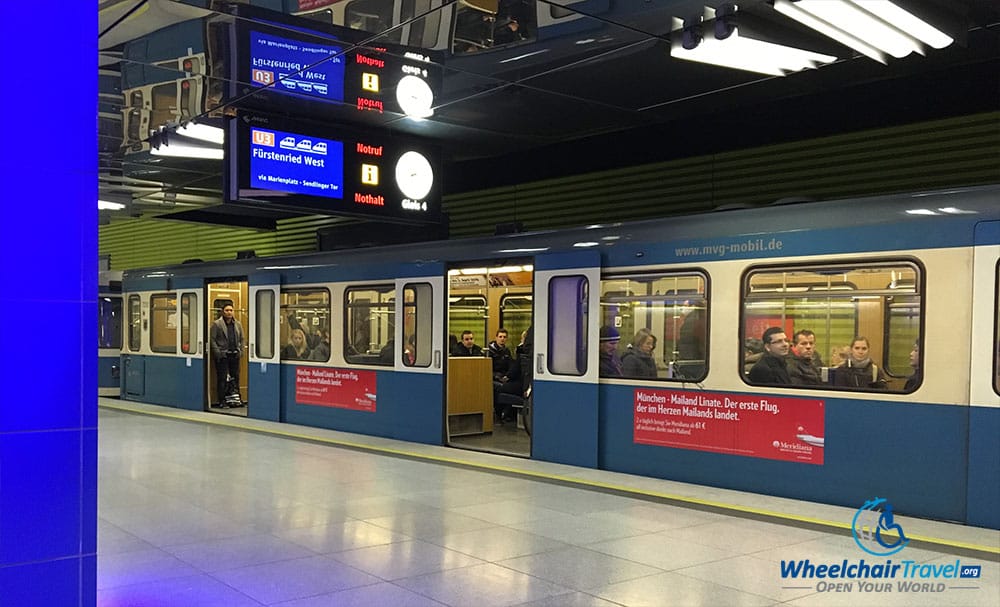
The gap between the U-Bahn trains and station platforms is negligible, but the train floor may be up to 3 inches higher than the platform on certain lines and at certain stations. The height difference on most of the trains I took was between 0 and 2 inches. My power wheelchair was able to handle the greater 3-inch difference if I approached the train’s doorway head-on and at a speed faster than a crawl. On two occasions, I wasn’t paying attention and approached at an angle, which caused my wheelchair to become momentarily stuck. In these two instances, other riders assisted in pushing me onto the train – the German people are very kind and always willing to lend a helping hand.
On the vast majority of my U-Bahn trips, there were no barriers to access whatsoever, from the street to the train car itself. Wheelchair accessible spaces are available onboard the train, in the front car. You should always plan to board in the front car, as this is where the operator is located. If you encounter an issue, the train operator can assist you.
Stations are equipped with electronic signboards that notify commuters of approaching and departing trains. Audio announcements are also made (in German and English) throughout the network and on trains.
A map of the entire U-Bahn network is available here (PDF). I will discuss fares–how much they cost and where to purchase them– later in this article.
S-Bahn Regional Trains
The S-Bahn is a regional train system that provides service within Munich, but also to locations outside of the city limits. The S-Bahn operates in many of the same stations as the U-Bahn, but typically on different tracks that are a level above or below the U-Bahn. The network consists of 8 lines, designated as S1, S2, S3, S4, S6, S7, S8 and S20. Your guess is as good as mine, as to why they didn’t number them 1 through 8. If someone tells you to get on S5, they’re playing a trick on you. :p
Most S-Bahn stations are wheelchair accessible, from the street to the platform. The Munich Transport and Tariff Association (MVV) claims that 85-percent of S-Bahn stations offer barrier free access. While I haven’t visited all 150 stations, I can say that I never found a station that was not accessible during the course of my trip. I took the S-Bahn to many popular tourist sites, including the Dachau Concentration Camp.
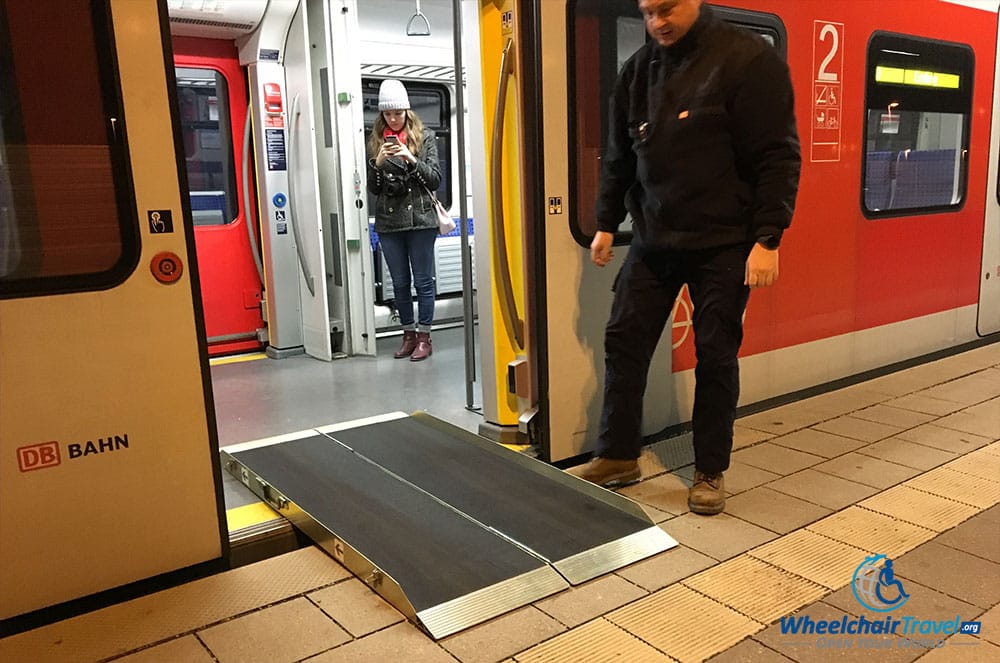
S-Bahn trains are larger than their U-Bahn counterparts, and the gap between the train and platform is typically wider and taller as well. Thankfully, all S-Bahn trains are equipped with a portable ramp that the train conductor can lay out to create access for your wheelchair. The ramp is stored in a compartment inside the first car. To request the ramp, flag down the train operator as he/she approaches, and they will get up to set-up the ramp for you. I was never left behind by an S-Bahn train, and the conductors were exceedingly kind.
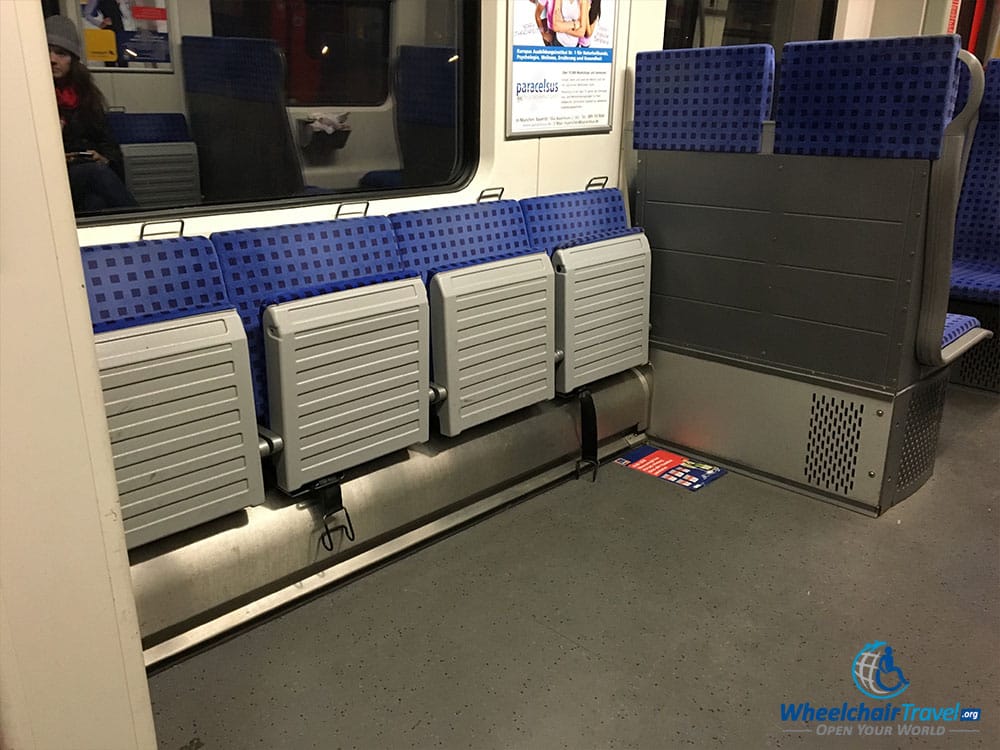
The first car of each S-Bahn train has a dedicated wheelchair space. There are seats that fold down from the wall, so that ambulatory passengers can use them when wheelchair passengers are not onboard. There is a wheelchair signal button on the wall/bulkhead to the left (not pictured) that wheelchair users should push when they wish to disembark. This button notifies the conductor that he/she will need to deploy the ramp for you. You can also tell the conductor where you plan to get off when you board. It still doesn’t hurt to push the button, or ask someone to do it for you.
On one of my S-Bahn rides, I witnessed something I had never seen before – two other wheelchair users were on the train with me! If you back your wheelchair in against the fold-down seats, you can comfortably fit two wheelchairs on each side of the train car. I was excited to be part of three wheelchairs on the same train, as I’ve never seen that anywhere – not even in the United States.
Like the U-Bahn, stations contain electronic signboards that notify commuters of approaching and departing trains. Audio announcements are also made (in German and English) throughout the network and on trains.
Service to/from the airport: S-Bahn lines S1 and S8 offer service to the city center from Munich Airport. Follow the green S-Bahn sign to the station beneath the airport’s Terminal 1. If you are going between the airport and city center, you will cross four fare zones.
A map of the S-Bahn network is available here.
City Bus
Munich’s city bus network consists of 69 individual routes, which cover 467 kilometers of roadway and serve 968 different stops. The vast majority of buses have lowered floors and are wheelchair accessible by manual ramp, electronic ramp, or wheelchair lift. During my time in Munich, I did not see a single bus that was not wheelchair accessible, but a small number do remain in the fleet.
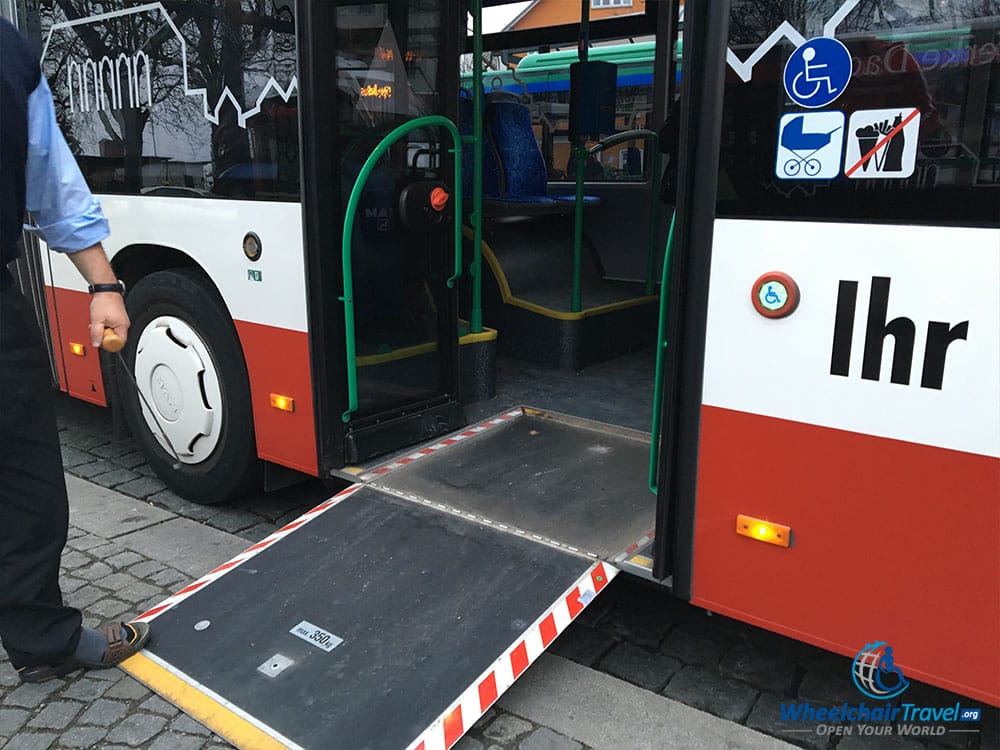
Pictured above is one of the buses with a manual ramp that the driver must fold out. Here, the ramp’s incline was minimal, but it can be steeper depending on the design of the stop location. Wheelchair users should either flag the bus driver to request assistance, or push the wheelchair button to the right of the center door. The bus contains a space for a wheelchair opposite the door, similar to the designs found in the majority of other countries.
For a map of the Munich city bus network, click here (PDF).
Trams
Munich has an on-street tram network that consists of 13 lines and 166 stops (PDF source). I have not ridden any of the trams in Munich, and I’m not into making stuff up – that is dangerous, and happens all too often on other accessible travel blogs. What I can do is pass on the following description of tram accessibility, which is taken from the MVV website. It is two bullet points:
- Almost all vehicles running on the tram network have been adapted to the needs of disabled passengers – including those which run throughout the night.
- 126 of the 148 tram stops provide easy access for disabled passengers.
If you have any personal experience with the trams in Munich, please share what you know in the comments below.
Fares, Tickets and Passes
Purchasing tickets for public transportation can be a confusing process in any city. I’ll try to simplify that madness with this guide, and I’ll also offer some tips on how to get the best deal.
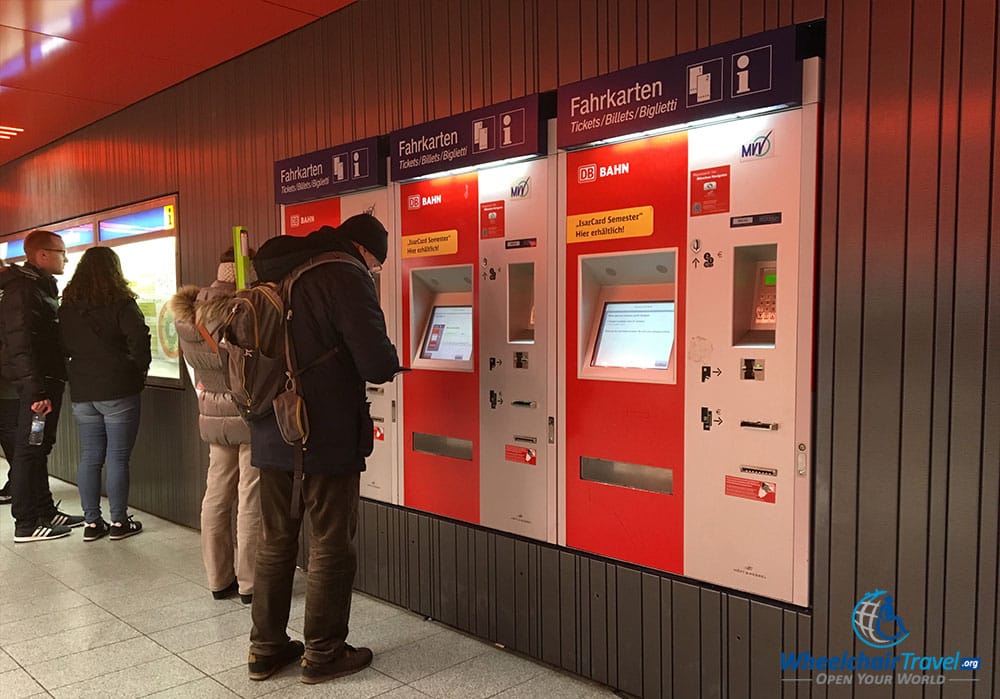
First off – the best place to purchase tickets and passes for the S-Bahn, U-Bahn, tram and city bus is at an electronic ticketing machine, like the one pictured above. These machines can be found in all S- and U-Bahn stations. They accept credit cards, cash and coins.
Fares on the Munich public transportation system are zone-based. There are 4 different fare zones in Munich, which you can see highlighted on this map (PDF). The price of single trip (one-way) tickets is based on the number of zones you travel through:
1 Zone: €2,70
2 Zones: €5,40
3 Zones: €8,10
4 Zones or more: €10,80
This means that your maximum fare for travel in a single direction, using any combination of the public transit services, is €10,80. For short trips, there is a “short trip” fare of €1,30 – this ticket allows you to travel a maximum of 4 stops, but only two of those can involve the S-Bahn, U-Bahn, or express buses (routes starting with the letter ‘X’).
If you’re looking to save money on fares, considering purchasing an unlimited day pass. The more often you use the public transit system, the more value you’ll get out of a pass. Unlimited ride passes are also priced according to the number of zones you’d like to include. The fare chart is based on the color-coded zone map:
Inner District (white zone): €6,40
Munich XXL (white & green zones): €8,60
Outer District (green, yellow & red zones): €6,40
Entire Network (all 4 zones): €12,40
As you can see, buying a round trip ticket for travel across zones is a very bad idea – that would cost €21,60. The all-day, unlimited ride pass for the entire network is only €12,40. Take advantage of the discounted passes if you intend to use public transportation more than once or twice!
The complete fare schedule is available here. I am sad to report that there are no discounts for people with disabilities.
National & International Passenger Rail
München Hauptbahnhof is the main train station in Munich. All 8 S-Bahn trains stop there, as do U-Bahn lines U1, U2, U4 and U5. Munich Hbf is where you’ll need to go to catch trains bound for other cities in Germany (beyond those served by the Munich S-Bahn) and for international destinations.
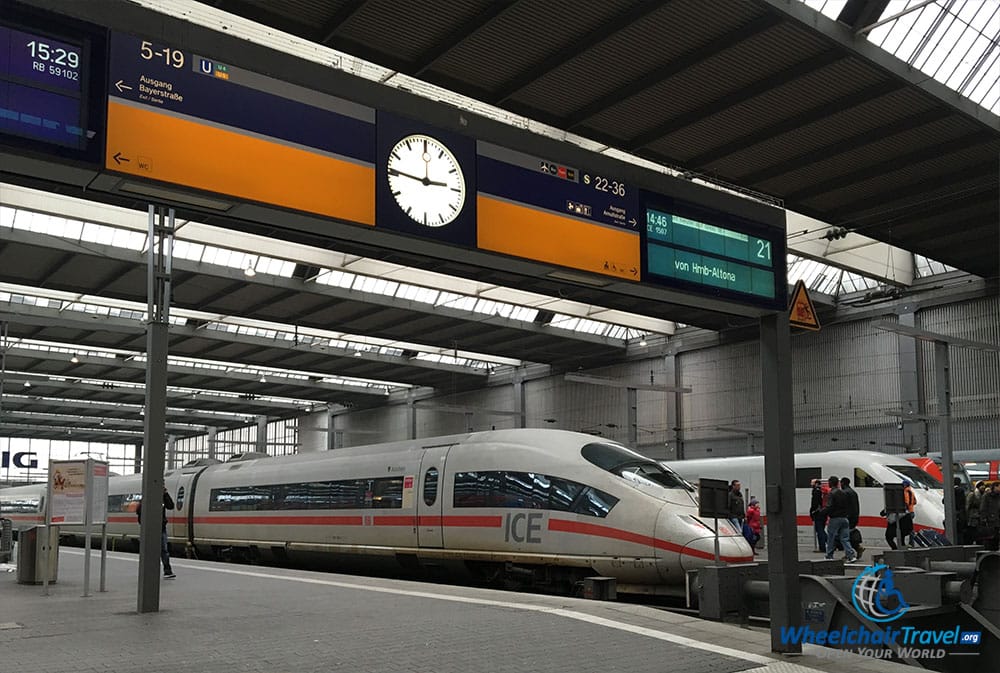
I know that the ICE high-speed trains, the ALEX train to Prague, and many Deutsche Bahn regional trains operate from this station. To give you the full picture of rail services operating there, I’ve consulted Wikipedia:
The station is the southern point of the InterCityExpress line to Hamburg-Altona via the Hanover-Würzburg high-speed rail line. It also has frequent links to Dortmund via Frankfurt and Cologne using the Cologne-Frankfurt high-speed rail line. The most recent addition is the Nuremberg-Ingolstadt high-speed rail line, which has greatly benefited from Munich traffic. Additional ICE services using mainly ordinary lines on their run exist to Vienna, Berlin and a number of other cities. There are also numerous InterCity and EuroCity services to most parts of Germany as well as neighbouring Austria, Switzerland, France and Italy. The station has a number of DB NachtZug and CityNightLine services to northern Germany, the Netherlands, Denmark, France and Italy, though facilities for the autoracks in these night services are located at München Ost railway station. Night services operated by other railway companies also can be seen at the station, for example to Moscow, Budapest or Zagreb.
You can find out more about the station itself on the DB Bahn website (German only).



